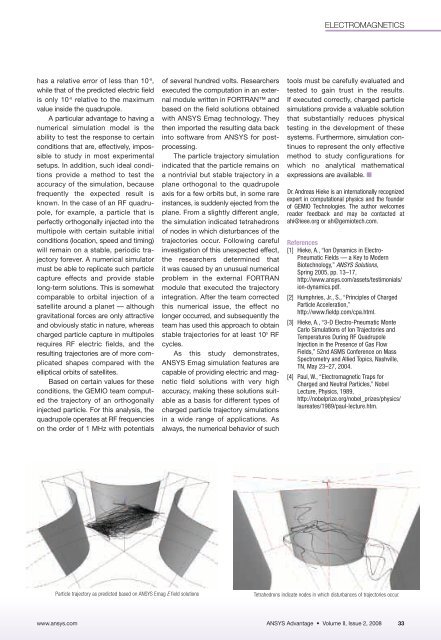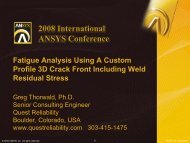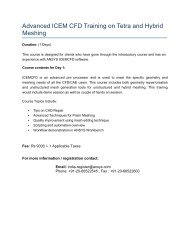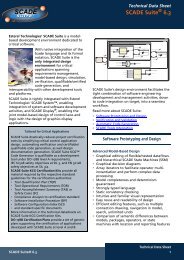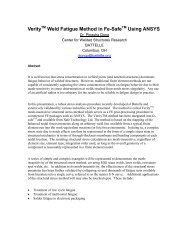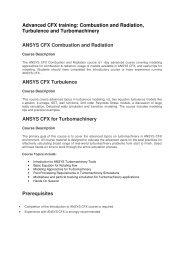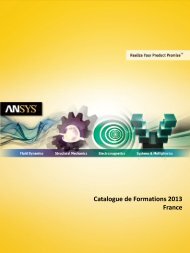Simulation - ANSYS
Simulation - ANSYS
Simulation - ANSYS
You also want an ePaper? Increase the reach of your titles
YUMPU automatically turns print PDFs into web optimized ePapers that Google loves.
has a relative error of less than 10 -8 ,<br />
while that of the predicted electric field<br />
is only 10 -6 relative to the maximum<br />
value inside the quadrupole.<br />
A particular advantage to having a<br />
numerical simulation model is the<br />
ability to test the response to certain<br />
conditions that are, effectively, impossible<br />
to study in most experimental<br />
setups. In addition, such ideal conditions<br />
provide a method to test the<br />
accuracy of the simulation, because<br />
frequently the expected result is<br />
known. In the case of an RF quadrupole,<br />
for example, a particle that is<br />
perfectly orthogonally injected into the<br />
multipole with certain suitable initial<br />
conditions (location, speed and timing)<br />
will remain on a stable, periodic trajectory<br />
forever. A numerical simulator<br />
must be able to replicate such particle<br />
capture effects and provide stable<br />
long-term solutions. This is somewhat<br />
comparable to orbital injection of a<br />
satellite around a planet — although<br />
gravitational forces are only attractive<br />
and obviously static in nature, whereas<br />
charged particle capture in multipoles<br />
requires RF electric fields, and the<br />
resulting trajectories are of more complicated<br />
shapes compared with the<br />
elliptical orbits of satellites.<br />
Based on certain values for these<br />
conditions, the GEMIO team computed<br />
the trajectory of an orthogonally<br />
injected particle. For this analysis, the<br />
quadrupole operates at RF frequencies<br />
on the order of 1 MHz with potentials<br />
of several hundred volts. Researchers<br />
executed the computation in an external<br />
module written in FORTRAN and<br />
based on the field solutions obtained<br />
with <strong>ANSYS</strong> Emag technology. They<br />
then imported the resulting data back<br />
into software from <strong>ANSYS</strong> for postprocessing.<br />
The particle trajectory simulation<br />
indicated that the particle remains on<br />
a nontrivial but stable trajectory in a<br />
plane orthogonal to the quadrupole<br />
axis for a few orbits but, in some rare<br />
instances, is suddenly ejected from the<br />
plane. From a slightly different angle,<br />
the simulation indicated tetrahedrons<br />
of nodes in which disturbances of the<br />
trajectories occur. Following careful<br />
investigation of this unexpected effect,<br />
the researchers determined that<br />
it was caused by an unusual numerical<br />
problem in the external FORTRAN<br />
module that executed the trajectory<br />
integration. After the team corrected<br />
this numerical issue, the effect no<br />
longer occurred, and subsequently the<br />
team has used this approach to obtain<br />
stable trajectories for at least 10 5 RF<br />
cycles.<br />
As this study demonstrates,<br />
<strong>ANSYS</strong> Emag simulation features are<br />
capable of providing electric and magnetic<br />
field solutions with very high<br />
accuracy, making these solutions suitable<br />
as a basis for different types of<br />
charged particle trajectory simulations<br />
in a wide range of applications. As<br />
always, the numerical behavior of such<br />
ELECTROMAGNETICS<br />
tools must be carefully evaluated and<br />
tested to gain trust in the results.<br />
If executed correctly, charged particle<br />
simulations provide a valuable solution<br />
that substantially reduces physical<br />
testing in the development of these<br />
systems. Furthermore, simulation continues<br />
to represent the only effective<br />
method to study configurations for<br />
which no analytical mathematical<br />
expressions are available. ■<br />
Dr. Andreas Hieke is an internationally recognized<br />
expert in computational physics and the founder<br />
of GEMIO Technologies. The author welcomes<br />
reader feedback and may be contacted at<br />
ahi@ieee.org or ah@gemiotech.com.<br />
References<br />
[1] Hieke, A., “Ion Dynamics in Electro-<br />
Pneumatic Fields — a Key to Modern<br />
Biotechnology,” <strong>ANSYS</strong> Solutions,<br />
Spring 2005, pp. 13–17,<br />
http://www.ansys.com/assets/testimonials/<br />
ion-dynamics.pdf.<br />
[2] Humphries, Jr., S., “Principles of Charged<br />
Particle Acceleration,”<br />
http://www.fieldp.com/cpa.html.<br />
[3] Hieke, A., “3-D Electro-Pneumatic Monte<br />
Carlo <strong>Simulation</strong>s of Ion Trajectories and<br />
Temperatures During RF Quadrupole<br />
Injection in the Presence of Gas Flow<br />
Fields,” 52nd ASMS Conference on Mass<br />
Spectrometry and Allied Topics, Nashville,<br />
TN, May 23–27, 2004.<br />
[4] Paul, W., “Electromagnetic Traps for<br />
Charged and Neutral Particles,” Nobel<br />
Lecture, Physics, 1989,<br />
http://nobelprize.org/nobel_prizes/physics/<br />
laureates/1989/paul-lecture.htm.<br />
Particle trajectory as predicted based on <strong>ANSYS</strong> Emag E field solutions Tetrahedrons indicate nodes in which disturbances of trajectories occur.<br />
www.ansys.com <strong>ANSYS</strong> Advantage • Volume II, Issue 2, 2008 33


